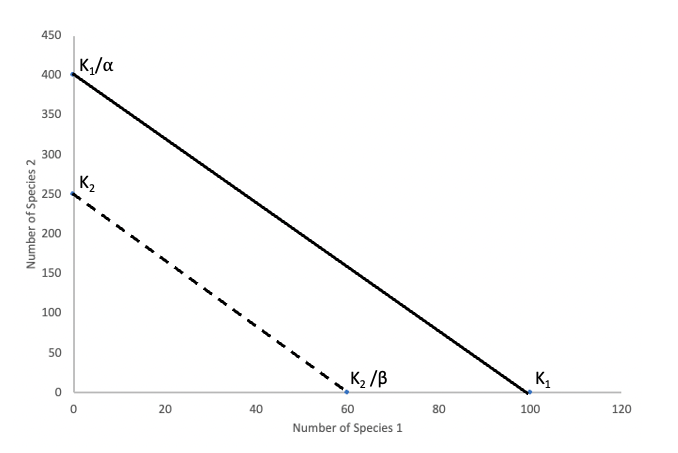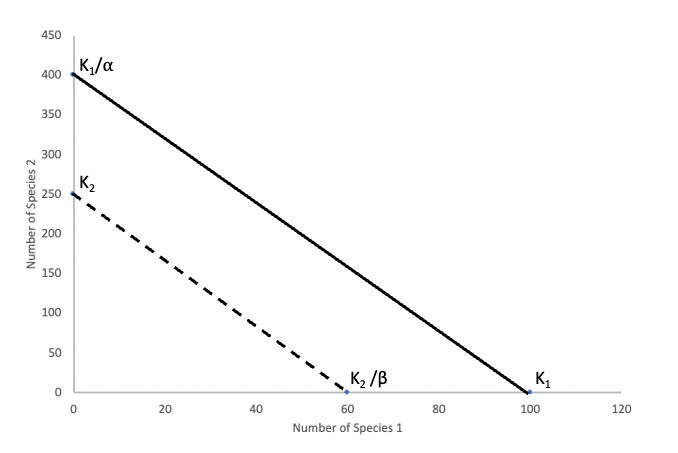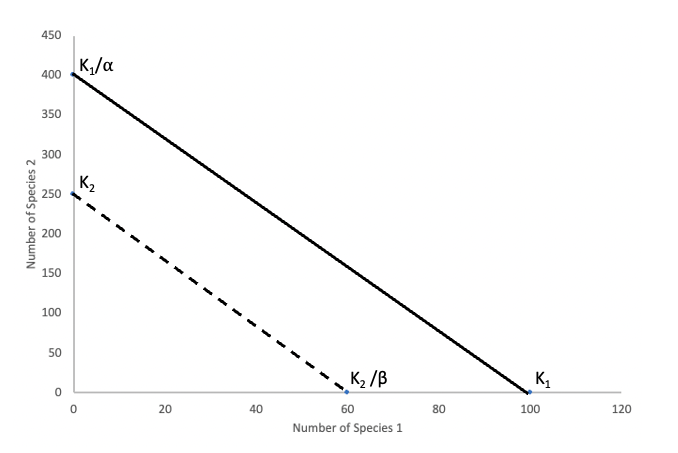Ecology review for final
0.0(0)
0.0(0)
Card Sorting
1/162
Earn XP
Description and Tags
Chp22-landscape ecology Chp.23 Global conservation , and review exam material
Study Analytics
Name | Mastery | Learn | Test | Matching | Spaced |
|---|
No study sessions yet.
163 Terms
1
New cards
A social interaction in which both the donor's fitness and the recipient's fitness are increased is called.
cooperation
2
New cards
\
A type _____ functional response occurs when a predator's rate of prey consumption increases linearly with increasing prey and then satiates.
A type _____ functional response occurs when a predator's rate of prey consumption increases linearly with increasing prey and then satiates.
type II
3
New cards
\
Animals that live in groups have a reduced individual probability of predation. This is known as
Animals that live in groups have a reduced individual probability of predation. This is known as
dilution effect
4
New cards
Huffaker's laboratory experiment of predator and prey species of mites demonstrated that predator and prey cycles
stabilize when prey have refuges.
5
New cards
\
In Lotka-Volterra models of predator-prey interactions, c represents
In Lotka-Volterra models of predator-prey interactions, c represents
the probability of an encounter leading to prey's capture.
6
New cards
The coefficient of relatedness measures
the probability of an individual and its relatives carrying copies of the same genes from a recent common ancestor.
7
New cards
The viceroy (Limenitis archippus) is a palatable North American butterfly that has coloration similar to that of another species of unpalatable butterfly, the monarch (Danaus plexippus). This is an example of
Batesian mimicry
8
New cards
\
What is the driving force in the 10-year cycle of lynx and hare abundance?
What is the driving force in the 10-year cycle of lynx and hare abundance?
predation
9
New cards
\
Interspecific competition occurs
Interspecific competition occurs
when any two different species compete for a limited resource.
10
New cards
\
The competitive exclusion principle states that two organisms cannot coexist indefinitely when they
The competitive exclusion principle states that two organisms cannot coexist indefinitely when they
are limited by the same resources.
11
New cards
The mathematical models for competition between species are based on the _____ equation.
logistic population growth
12
New cards

When considering the phase diagram below, the dotted line represents the zero net growth isocline (ZNGI) for which species?
Species 2
13
New cards

When considering the phase diagram below, to what population size would species 1 grow if species 2 is absent from the interaction?
100
14
New cards

When considering the phase diagram below, what is the outcome of interspecific competition between species 1 and 2?
Species 1 outcompetes and excludes species 2
15
New cards
\
When wolves and coyotes compete, reductions in numbers of coyotes are attributed to a virus the wolves carry that is more harmful in coyotes. This is an example of
When wolves and coyotes compete, reductions in numbers of coyotes are attributed to a virus the wolves carry that is more harmful in coyotes. This is an example of
apparent competition.
16
New cards
\
Organisms that feed at more than one trophic level are called __________.
Organisms that feed at more than one trophic level are called __________.
Omnivores
17
New cards
\
Please choose from the lists below the proper order of three words that best characterize the three mechanisms of succession proposed by Connell and Slatyer: facilitation, inhibition, and tolerance. The words should relate properly to the effect of one species on the probability of a second species becoming established during succession.
Please choose from the lists below the proper order of three words that best characterize the three mechanisms of succession proposed by Connell and Slatyer: facilitation, inhibition, and tolerance. The words should relate properly to the effect of one species on the probability of a second species becoming established during succession.
positive, negative, neutral
18
New cards
\
The Island of Krakatau has provided an ideal setting for studies of which kind of succession?
The Island of Krakatau has provided an ideal setting for studies of which kind of succession?
primary
19
New cards
The ultimate association of species terminating a succession is called a __________ community.
climax
20
New cards
Which of the following concepts of community organization suggests that a community is much more than the sum of its individual parts?
holistic concept
21
New cards
Consider a biologist studying a population of deer. At the beginning of the year, there are 100 adult deer in the population. Over the course of the year, 15 adult deer die, and an additional 25 deer are born. What can we conclude about *r* for this year?
a metapopulation.
22
New cards
Consider a biologist studying a population of deer. At the beginning of the year, there are 100 adult deer in the population. Over the course of the year, 15 adult deer die, and an additional 25 deer are born. What can we conclude about *r* for this year?
*r* > 1
23
New cards
Consider moose that breed in the fall and give birth in the spring. During breeding, the moose population is below carrying capacity, but once the young moose are born, the moose population far exceeds carrying capacity. This is an example of
delayed density dependence.
24
New cards
Ecology is:
The study of the interactions of organisms with one another and the environment
\
The study of the distribution and abundance of organisms
\
The study of the distribution and abundance of organisms
25
New cards
26
New cards
In the example of Nemoria caterpillars’ mimicking oak tree structures, Erick Greene monitored the development of individual caterpillars in separate containers under treatments of different temperature, photoperiod, or diet. \n The response variable in this example is:
The development into either catkin or twig mimics
27
New cards
In what way is the geometric growth model different from the exponential growth model?
**The geometric growth model uses regular time intervals.**
28
New cards
Which form of population growth results in an S-shaped curve?
logistic growth
29
New cards
A mature female sockeye salmon swims up to 5,000 km from her Pacific Ocean feeding ground to the mouth of a coastal river in British Columbia and then another 1,000 km upstream to her spawning ground. Once there, she lays thousands of eggs in her single reproductive event and promptly dies. The salmon's reproductive life history is
semelparous
30
New cards
Fecundity is
the number of offspring produced by an organism per reproductive episode.
31
New cards
How does having a large number of offspring affect a parent's fitness for subsequent breeding seasons?
The increased energy needed to feed many offspring may lower adult survival in the following breeding season.
32
New cards
The principle of allocation states that life history traits are adapted to maximize
fitness
33
New cards
Which life history type do mammals exhibit?
\
\
convection
34
New cards
An endemic species is one that
has a relatively restricted distribution.
35
New cards
\
Declines in genetic diversity can
Declines in genetic diversity can
\
reduce the probability that a population will survive changing environmental conditions.
reduce the probability that a population will survive changing environmental conditions.
36
New cards
The California condor (Gymnogyps californianus) was saved from extinction by
captive breeding and species reintroduction.
37
New cards
The Svalbard facility on an island north of the Norwegian mainland was constructed to store
\
seeds.
seeds.
38
New cards
The cancer drug Taxol, which originally came from the Pacific yew tree (Taxus brevifolia), is an example of a _____ service.
provisioning
39
New cards
\
The collapse of the Atlantic cod fishery in the early 1990s was the result of
The collapse of the Atlantic cod fishery in the early 1990s was the result of
overharvesting.
40
New cards
The largest cause of declining biodiversity is
habitat loss.
41
New cards
What is the process by which the concentration of a contaminant increases as it moves up the food chain?
\
biomagnification
biomagnification
42
New cards
Which chemical caused declines in predatory bird populations in the 1950s and 1960s in the United States?
DDT
43
New cards
\
In which biogeographic region is the United States?
In which biogeographic region is the United States?
Nearctic
44
New cards
About 250 million years ago, all of Earth's landmasses were joined as a single landmass called
Pangaea.
45
New cards
\
The movement of landmasses across the surface of Earth is called
The movement of landmasses across the surface of Earth is called
\
continental drift.
continental drift.
46
New cards
\
For marine organisms, the highest diversity is seen at _____ and the lowest diversity is seen at _____.
For marine organisms, the highest diversity is seen at _____ and the lowest diversity is seen at _____.
low latitudes; high latitudes
47
New cards
\
Based on the theory of island biogeography, which statement about reserve designs is TRUE?
Based on the theory of island biogeography, which statement about reserve designs is TRUE?
One large reserve is better than many small reserves.
48
New cards
\
The equilibrium theory of island biogeography states that the number of species on an island reflects a balance between
The equilibrium theory of island biogeography states that the number of species on an island reflects a balance between
colonization of new species and extinction of existing species
49
New cards
\
MacArthur and Wilson's theory of island biogeography considers both species–area relationships and
MacArthur and Wilson's theory of island biogeography considers both species–area relationships and
isolation.
50
New cards
\
Small intervening patches that dispersing organisms can use to move between large favorable habitats are called
Small intervening patches that dispersing organisms can use to move between large favorable habitats are called
stepping stones.
51
New cards
\
Which of the following is NOT an effect of fragmentation of a large contiguous habitat?
Which of the following is NOT an effect of fragmentation of a large contiguous habitat?
The amount of edge habitat decreases.
52
New cards
\
A classic study by MacArthur and Wilson demonstrated that as the size of islands increases, species
A classic study by MacArthur and Wilson demonstrated that as the size of islands increases, species
richness increases.
53
New cards
\
Local species diversity is also called _____ diversity.
Local species diversity is also called _____ diversity.
alpha
54
New cards
A long-lasting influence of historical processes on the current ecology of an area is called a _____ effect.
\
legacy
legacy
55
New cards
\
Which field considers the spatial arrangement of habitats at different scales?
Which field considers the spatial arrangement of habitats at different scales?
landscape ecology
56
New cards
\
The reduction in habitat size resulting from fragmentation causes a decline in species diversity for what reason?
The reduction in habitat size resulting from fragmentation causes a decline in species diversity for what reason?
\
Fragments support smaller populations that are more prone to extinction.
Fragments support smaller populations that are more prone to extinction.
57
New cards
\
On which type of island should we expect to see the lowest level of biodiversity when equilibrium is reached?
On which type of island should we expect to see the lowest level of biodiversity when equilibrium is reached?
\
a small island located far from the source of colonizing species.
a small island located far from the source of colonizing species.
58
New cards
In the Northern Hemisphere, the number of species of plants generally
increases from north to south.
59
New cards
\
Based on the theory of island biogeography, which statement about reserve designs is TRUE?
Based on the theory of island biogeography, which statement about reserve designs is TRUE?
\
One large reserve is better than many small reserves
One large reserve is better than many small reserves
60
New cards
As habitat _____, species diversity _____.
heterogeneity increases; increases
61
New cards
\
All of the species in all of the habitats that constitute a large geographic area are called
All of the species in all of the habitats that constitute a large geographic area are called
\
regional diversity.
regional diversity.
62
New cards
\
About 150 million years ago THE single landmass separated into northern and southern landmasses called
About 150 million years ago THE single landmass separated into northern and southern landmasses called
Laurasia and Gondwana.
63
New cards
Which field considers the spatial arrangement of habitats at different scales?
landscape ecology
64
New cards
A long-lasting influence of historical processes on the current ecology of an area is called a _____ effect .
legacy
65
New cards
Eskers are legacy effects of
glaciers.
66
New cards
Researchers studying soil conditions and plant species between 1 and 500 meters from former Roman settlements found that sites closer to settlements had
all of the above
(Higher PH, more available phosphorus, greater species richness)
(Higher PH, more available phosphorus, greater species richness)
67
New cards
As habitat _____, species diversity _____
heterogeneity increases; increases
68
New cards
The number of species in a relatively small area of homogeneous habitat is called
local diversity
69
New cards
Local species diversity is also called _____ diversity
alpha
70
New cards
All of the species in all of the habitats that constitute a large geographic area are called
regional diversity.
71
New cards
Regional species diversity is also called _____ diversity.
gamma
72
New cards
A regional species pool is the collection of species
that differ in occurrence within a region.
73
New cards
Arranging species in the regional pool among localities according to their adaptations and interactions is called _____ sorting.
species
74
New cards
A classic study by MacArthur and Wilson demonstrated that as the size of islands increases, species
richness increases.
75
New cards
In species–area curves, S represents
number of species.
76
New cards
Which of the following equations describes the species–area curve?
S = cA^z
77
New cards
Which of the following describes the log-log form of the species area curve?
log S = log c + z log A
78
New cards
In the log-log form of the species–area curve, the slope of the relationship, z, is typically
0\.2 to 0.35.
79
New cards
Which of the following is NOT an effect of fragmentation of a large contiguous habitat?
The amount of edge habitat decreases
80
New cards
Which is NOT a way that edge habitat differs from interior habitat
Edge habitat has higher soil moisture.
81
New cards
When habitat is fragmented, a(n) _____ forms along the edges.
ecotone
82
New cards
Small intervening patches that dispersing organisms can use to move between large favorable habitats are called
stepping stones.
83
New cards
A graph of the number of species observed in relation to the number of individuals sampled is called a species _____ curve
accumulation
84
New cards
MacArthur and Wilson’s theory of island biogeography considers both species–area relationships and
isolation.
85
New cards
The equilibrium theory of island biogeography states that the number of species on an island reflects a balance between
colonization of new species and extinction of existing species
86
New cards
4\. In the equilibrium theory of island biogeography, S^ occurs where extinction _____ colonization.
equals
87
New cards
Smaller islands at equilibrium contain fewer species than larger islands at equilibrium because smaller islands have
greater extinction.
88
New cards
Islands at equilibrium that are farther from the mainland contain fewer species than nearer islands at equilibrium because farther islands have
less colonization.
89
New cards
Which of the following would be expected to have the largest population at equilibrium?
large near island
90
New cards
Based on the theory of island biogeography, which statement about reserve designs is TRUE
One large reserve is better than many small reserves.
91
New cards
In the Northern Hemisphere, the number of species of plants generally
increases from north to south
92
New cards
For marine organisms, the highest diversity is seen at _____ and the lowest diversity is seen at _____.
low latitudes; high latitudes
93
New cards
In North America, amphibian diversity is greatest in t
southeast
94
New cards
In North America, reptile diversity is greatest in the
south
95
New cards
Which of the following is NOT associated with low terrestrial diversity?
low precipitation
96
New cards
Given average temperature and humidity, potential evapotranspiration is the amount of water that could be
evaporated from the soil and transpired by plants
97
New cards
PET is a measurement that combines the amount of solar radiation and
precipitation.
98
New cards
According to the _____ hypothesis, sites with higher amounts of energy are able to support more species
energy-diversity
99
New cards
Marine environments are most diverse in _____ environments and most productive in _____ environments.
tropical; temperate
100
New cards
The movement of landmasses across the surface of the earth is called
continental drift